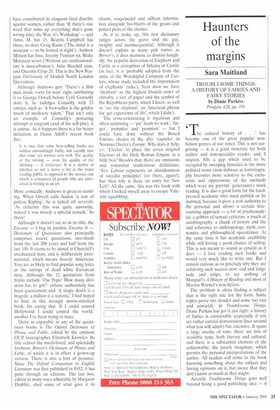Haunters of the margins
Sara Maitland
TROUBLESOME THINGS: A HISTORY OF FAIRIES AND FAIRY STORIES by Diane Purkiss Penguin, £20, pp. 356 he cultural history of . . .' has become one of the great popular nonfiction genres of our times. This is not surprising — it is a good structure for both author and non-specialist reader, and, I suspect, fills a gap which used to be occupied by sweeping histories in the more political sense (now dubious as historiography becomes more sensitive to the exclusions and oppressions of the method) which were my parents' generation's stock reading. It is also a good form for the hardpressed academic who must publish or be damned, because it gives a new authority to the personal and allows a certain freeroaming approach — a bit of psychoanalysis, a gobbet of textual criticism, a touch of autobiography, a chunk of history and the odd reference to anthropology, myth, economics and philosophical speculation. At the same time it has academic credibility while still having a good chance of selling. This is not meant to sound as cynical as it does — I love reading such books and would very much like to write one. But I remain curious as to precisely why they are achieving such success now: cod and longitude and tulips, to say nothing of Manguel's A History of Reading and most of Marina Warner's non-fiction.
The problem is often finding a subject that is the right size for the form. Some topics prove too slender and some too vast and unwieldy. In Troublesome Things, Diane Purkiss has got it just right: a history of fairies is containable (especially if you set rather careful demarcation lines around what you will admit) but extensive. It spans a large swathe of time: there are lots of available texts, both literary and cultural; and there is a substantial element of the unknowable, the purely imaginary, which permits the personal interpretations of the author. All readers will come to the book knowing something about the subject and having opinions on it, but aware that they don't know as much as they might.
Actually Troublesome Things goes well beyond being a good publishing idea — it
is a really interesting book. Purkiss begins by demolishing various theories about faerie — the celtic, the pre-christian, the Jungian — and goes on to locate the origins, perhaps rather challengingly, within the classical world of nymph and monster. She makes a good case, although I don't think she solves the transmission problem, nor — more seriously — how this relates to common themes that crop up in nonEuropean cultures. A direct route from the Lamia to `La Belle Dame Sans Merci' may be discernible; but one from the Lamia to Chirikudze (the water fairy of eastern Zimbabwe who also steals away young men and keeps them in thrall) is rather harder to map.
Once she has dealt with origins, Purkiss becomes more assured. There is a hideous gap between the terror of the changeling and the cuteness of Tinkerbell. Fairies have been infantilised and sugar-plummed beyond recognition. (I was in a jokeand fancy-dress shop recently and discovered that the fairy costumes and the angel costumes on offer were identical — both had wands and haloes.) Before the 19th century fairies were indeed troublesome, if not dangerous and often very dark indeed. Purkiss relates their stories to moments and places of transition, liminality, boundary (which is why they tend to inhabit forests, lakesides, barrows and cemeteries.) Death, birth and sexual initiation are the natural terrain of the fairies, whether they come into your home or steal you away to theirs. They provide an excuse for wrongdoing at these moments (for antisocial sexuality; for failing to love your child; for death itself). Their aspirations tend to be down-market
— getting rich and getting fed appeal especially to the poor and hungry. Fairies then could not easily survive either urbanisation or literary culture. From Shakespeare onwards their power diminished, as their physical shrinking bears witness. But Purkiss suggests something more than this — that rather than evaporating, fairies simply moved further out, to the now more distant boundaries. Her final chapter, suggesting that aliens are contemporary fairies, and that abductions and changelings continue in popular narrative, carries considerable imaginative authority.
Occasionally the tone is annoying. Purkiss can be too conversational in chatty bursts that grate. Sometimes she is overreductive or psychoanalytic (`The mermaid cannot possess the prince because of their difference. But here difference might represent sameness', usually, I suspect, because she does not give enough weight to the demands of story itself: tales make specific and independent demands on their tellers. But overall she creates a coherent narrative, and illustrates it from wide reading and a real diversity of disciplines, and presents the whole at a very attractive level — accessible without being simplistic. The book is both illuminating and enormous fun.



















































 Previous page
Previous page